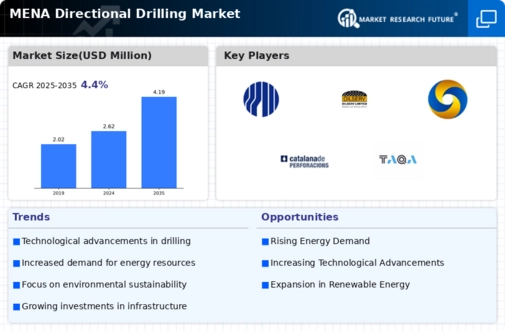Increasing Energy Demand
The MENA Directional Drilling Market is experiencing a surge in demand for energy resources, driven by the region's growing population and industrialization. As countries in the MENA region continue to develop, the need for oil and gas exploration intensifies. According to recent estimates, energy consumption in the MENA region is projected to increase by approximately 3% annually over the next decade. This rising demand for energy resources necessitates advanced drilling techniques, such as directional drilling, to access hard-to-reach reserves. Consequently, companies are investing in innovative technologies to enhance drilling efficiency and reduce operational costs, thereby propelling the growth of the MENA Directional Drilling Market.
Technological Innovations
Technological advancements play a pivotal role in shaping the MENA Directional Drilling Market. The introduction of advanced drilling technologies, such as rotary steerable systems and measurement-while-drilling (MWD) tools, has revolutionized the efficiency and accuracy of drilling operations. These innovations enable operators to drill complex well paths with greater precision, reducing the time and costs associated with drilling. Furthermore, the integration of data analytics and automation in drilling processes enhances decision-making and operational efficiency. As a result, the MENA Directional Drilling Market is likely to witness increased adoption of these technologies, leading to improved performance and reduced environmental impact.
Focus on Enhanced Oil Recovery
The MENA Directional Drilling Market is increasingly focusing on enhanced oil recovery (EOR) techniques to maximize output from existing fields. As conventional oil reserves become depleted, operators are turning to directional drilling methods to access untapped resources and improve recovery rates. EOR techniques, such as water flooding and gas injection, are being integrated with directional drilling to optimize production. This trend is particularly evident in mature oil fields across the MENA region, where the application of advanced drilling techniques can significantly enhance recovery efficiency. Consequently, the emphasis on EOR is likely to drive growth in the MENA Directional Drilling Market, as companies seek to extend the life of existing assets.
Regulatory Support and Investment
The MENA Directional Drilling Market benefits from supportive regulatory frameworks and increased investment in the energy sector. Governments in the region are actively promoting exploration and production activities to maximize hydrocarbon resources. For instance, several countries have introduced favorable policies and incentives to attract foreign investment in oil and gas exploration. This regulatory support is expected to stimulate growth in the directional drilling sector, as companies seek to capitalize on new opportunities. Additionally, the MENA region is witnessing a rise in joint ventures and partnerships between local and international firms, further enhancing the capabilities and resources available within the MENA Directional Drilling Market.
Geopolitical Stability and Investment Opportunities
Geopolitical stability in certain MENA countries is fostering a conducive environment for investment in the directional drilling sector. As nations work towards diversifying their economies and reducing dependence on oil revenues, there is a growing emphasis on developing the energy sector. This shift is attracting both domestic and foreign investments, which are crucial for advancing drilling technologies and infrastructure. The MENA Directional Drilling Market stands to benefit from this influx of capital, as companies are better positioned to undertake ambitious drilling projects. Furthermore, stable geopolitical conditions may lead to increased collaboration among regional players, enhancing the overall competitiveness of the MENA Directional Drilling Market.


















Leave a Comment